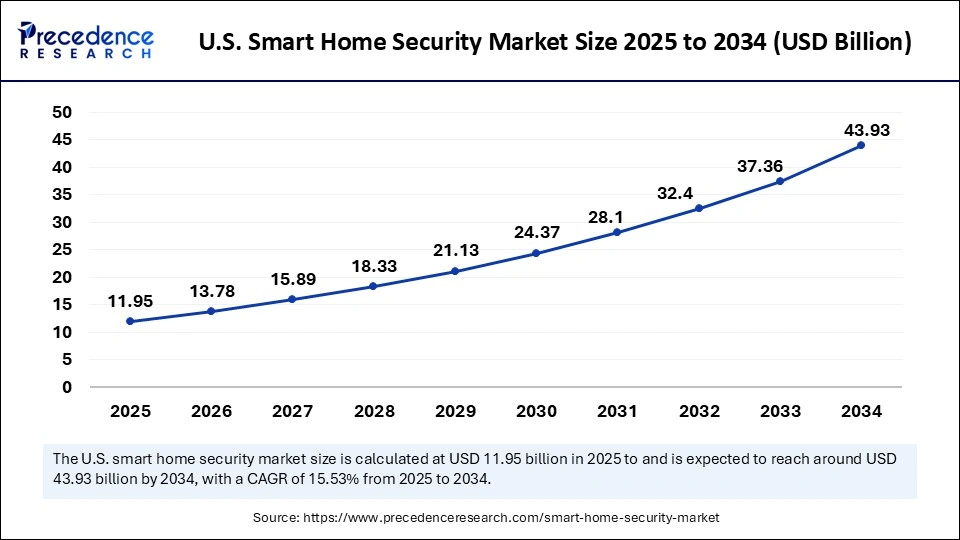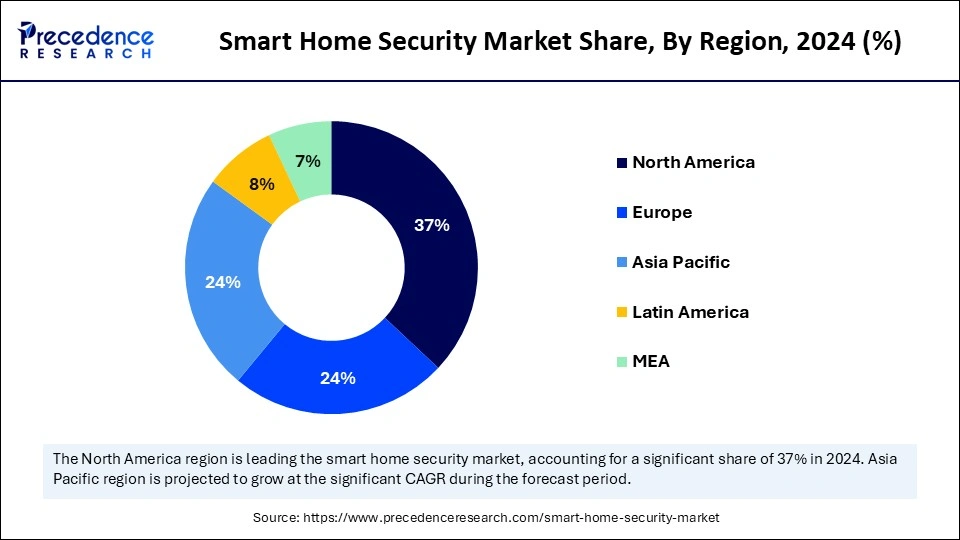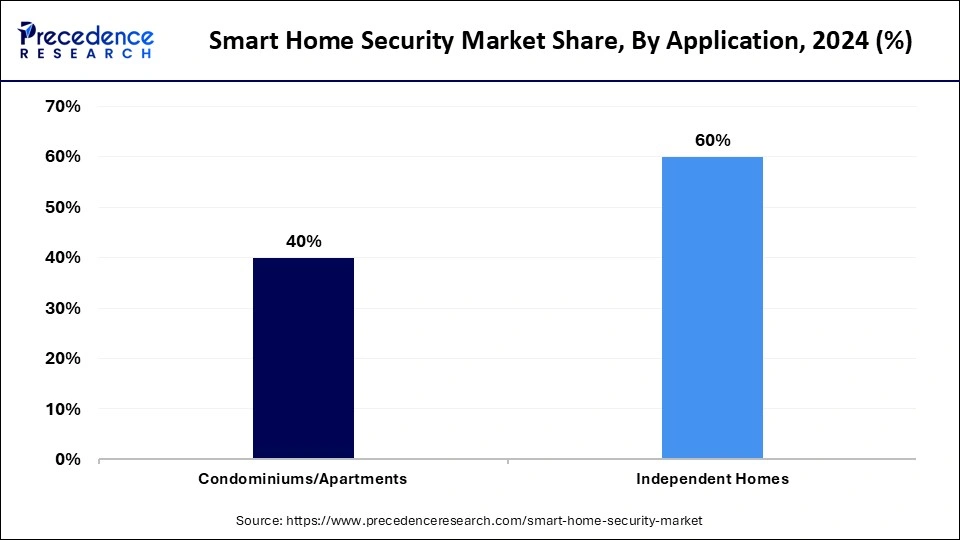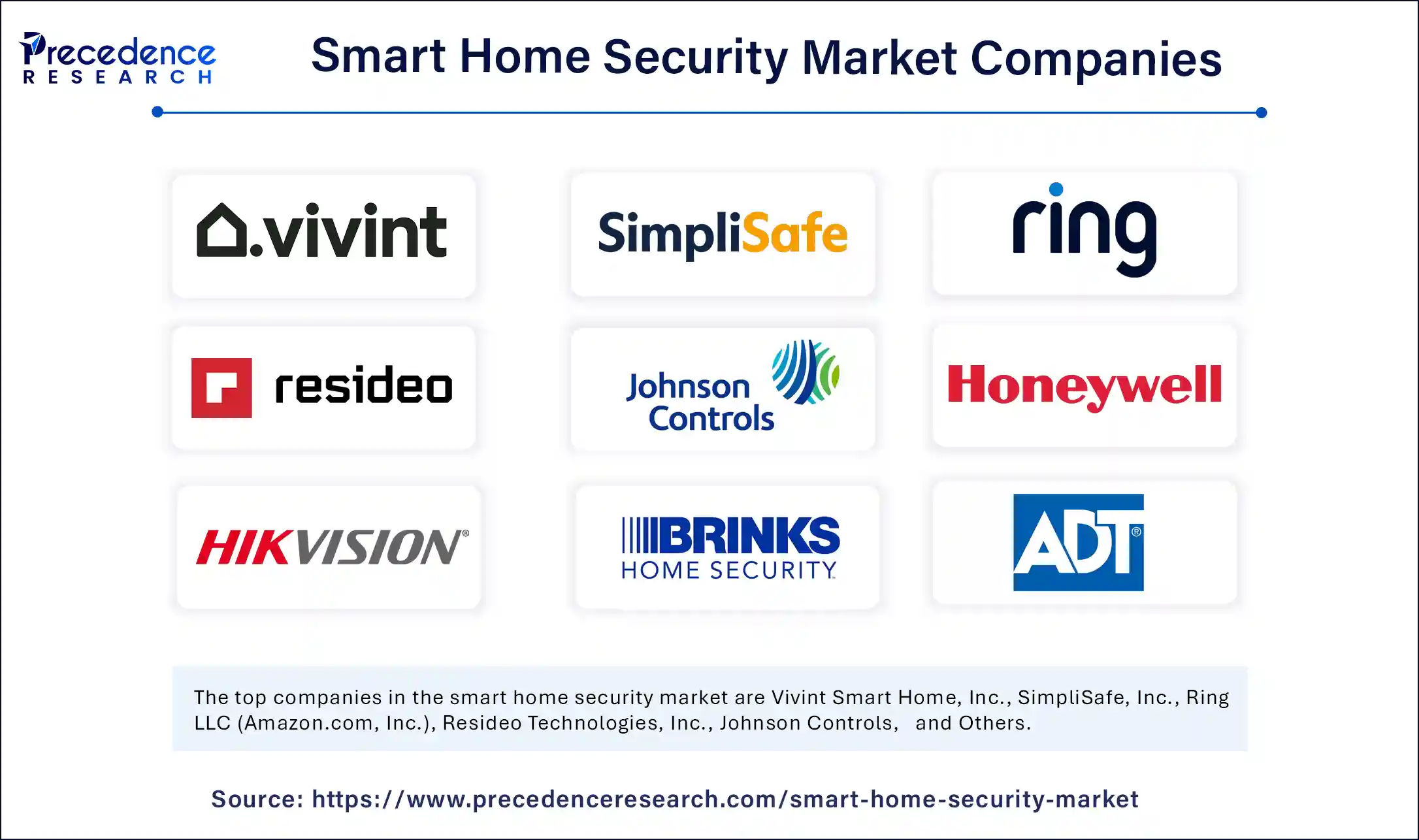List of Contents
Smart Home Security Market Size and Forecast 2025 to 2034
The global smart home security market size accounted for USD 35.02 billion in 2024 and is predicted to increase from USD 40.38 billion in 2025 to approximately USD 145.54 billion by 2034, expanding at a CAGR of 15.31% from 2025 to 2034. The market growth is attributed to the increasing demand for advanced, integrated security solutions driven by rising concerns over home safety and technological advancements in smart devices.

Smart Home Security Market Key Takeaways
- In terms of revenue, the smart home security market is valued at $ 40.38 billion in 2025.
- It is projected to reach $145.54 billion by 2034.
- The market is expected to grow at a CAGR of 15.31% from 2025 to 2034.
- North America dominated the global market by holding more than 37% share in 2024.
- Asia Pacific is expected to grow at a notable CAGR of 17.5% during the forecast period.
- By component, the hardware segment held the major market share of 57% in 2024.
- By component, the software segment is projected to grow at a solid CAGR of 18.2% between 2025 and 2034.
- By device type, the smart camera and monitoring segment accounted for the largest market share in 2024.
- By device type, the smart locks segment is anticipated to grow at the highest CAGR during the studied years.
- By connectivity, the wireless segment led the global market in 2024.
- By connectivity, the hybrid segment is projected to expand rapidly in the coming years.
- By application, the independent homes segment dominated the global market in 2024.
- By application, the condominiums/apartments segment is expected to grow at the fastest rate in the upcoming period.
Impact of Artificial Intelligence on the Smart Home Security Market
The implementation of artificial intelligence (AI) enhances the efficiency of smart home security technologies. AI empowers security providers with abilities to recognize faces while detecting motions and analyzing resident activities. Furthermore, the AI-powered systems analyze user patterns to adjust lighting, locks, and surveillance protocols that enhance user safety and add convenience to operations.
U.S. Smart Home Security Market Size and Growth 2025 to 2034
The U.S. smart home security market size was exhibited at USD 10.37 billion in 2024 and is projected to be worth around USD 43.93 billion by 2034, growing at a CAGR of 15.53% from 2025 to 2034.

North America led the smart home security market by capturing the largest share in 2024. This is mainly due to increased concerns regarding home security. There is a high adoption of smart home technologies, including home security solutions. The region has a well-established internet infrastructure, enabling seamless integration of smart home security systems. In addition, increased crime and burglary rates created the need for advanced home security solutions.
Residents in the U.S. and Canada who have high disposable income levels show interest in premium smart security solutions. The region is likely to sustain its position in the market due to the increasing demand for AI-driven security solutions. Furthermore, the availability of comprehensive security solutions that are compatible with smartphones supports regional market growth.

Asia Pacific is projected to witness the fastest growth during the forecast period. The growth of the market in the region is attributed to rapid urbanization and rising customer demand for smart home technologies. The rising disposable income further influences the market. With the rising crime rates and safety concerns, the need for security solutions is rising. Urban areas often face high burglary rates, which motivates homeowners to install smart home security solutions.
Europe is considered to be a significantly growing area. The growth of the smart home security market in Europe can be attributed to the widespread Internet access, enabling the adoption of smart and connected devices. The interest in smart security solutions has grown substantially in Germany, the UK, and France. These nations have intensified their emphasis on human safety and home protection. The European Union Agency for Cybersecurity (ENISA) reported that cybersecurity plays an essential role in protecting home security systems. The European governments are promoting smart home security solutions to ensure the safety of residential spaces, contributing to regional market growth.
Market Overview
The smart home security market is witnessing rapid growth due to the rising worries about individual security and property protection, particularly in towns that face growing security risks and crime statistics. Adoption of security solutions has increased dramatically over the last few years. The rising crime and theft rates are encouraging homeowners to seek advanced security solutions. The safety system integrates with various smart home devices to form a complete security network, which enables real-time oversight and distance-control operation. The World Health Organization (WHO) highlighted that urbanization, particularly in Asia Pacific, creates the need for security solutions.
Smart Home Security Market Growth Factors
- Rising Adoption of IoT Devices: The increasing integration of IoT-enabled devices in homes is expected to drive the demand for advanced smart security systems.
- Advancements in Artificial Intelligence: The ongoing advancements in AI and machine learning are anticipated to enhance the capabilities of smart home security systems, improving real-time monitoring and threat detection.
- Growing Urbanization: The rapid expansion of urban populations and the need for advanced security solutions in densely populated areas are projected to contribute to market growth.
- Increase in Remote Working: The rise in remote working and home-based lifestyles is likely to increase the demand for enhanced home security systems to protect personal and family spaces.
- Improved Consumer Awareness: As awareness about the benefits of smart security systems continues to grow, particularly regarding home safety and convenience, demand is expected to rise.
- Technological Advancements in Connectivity: The development of more seamless connectivity technologies, such as 5G, is expected to boost the performance and integration of smart home security solutions.
- Increase in Property Crimes: The rising concerns over property crimes and theft are likely to fuel the adoption of smart home security systems that offer real-time alerts and surveillance.
Market Scope
| Report Coverage | Details |
| Market Size by 2034 | USD 145.54 Billion |
| Market Size in 2025 | USD 40.38 Billion |
| Market Size in 2024 | USD 35.02 Billion |
| Market Growth Rate from 2025 to 2034 | CAGR of 15.31% |
| Dominating Region | North America |
| Fastest Growing Region | Asia Pacific |
| Base Year | 2024 |
| Forecast Period | 2025 to 2034 |
| Segments Covered | Component, Device Type, Connectivity, Application and Region |
| Regions Covered | North America, Europe, Asia-Pacific, Latin America, and Middle East & Africa |
Market Dynamics
Drivers
Increasing Demand for Real-Time Monitoring and Remote Access Solutions
The increasing consumer demand for real-time surveillance and control is expected to drive the growth of the smart home security market. Growing customer requests for real-time monitoring and command features contribute to increasing smart security system adoption. Households, particularly in urban and densely populated areas, give preference to remote monitoring with live video transmission and immediate mobile alert systems. People choose security solutions that provide real-time monitoring of unlawful activities because existing security systems do not meet these needs. The rising production of security solutions further supports market growth. Google Nest and Ring actively develop new products to serve customers more effectively while lowering security barriers. Furthermore, the growing need for real-time home monitoring to reduce emergency response times fuels the market.
Restraint
High Initial Costs of Smart Home Security Systems
The high upfront investment required for installing smart security systems is expected to restrain the growth of the smart home security market. The expanding accessibility of smart security technology fails to eliminate premium systems' costs. These systems are often equipped with advanced features, such as artificial intelligence-based cameras, motion detectors, and facial recognition capabilities. Premium prices deter price-sensitive consumers, especially in emerging markets and lower-income groups, from investing in these systems. Furthermore, the unwillingness to fund such systems among homeowners is likely to decrease market penetration rates, hindering the market's growth.
Opportunity
High Growth Potential in Emerging Markets
Rapid urbanization and rising disposable incomes in emerging economies offer substantial growth opportunities for the smart home security market. Asia Pacific, Latin America, and the Middle East are experiencing significant uptake of smart technologies in residential and commercial sectors. The International Telecommunication Union (ITU) reported that urban residents are more willing to spend money on smart home devices due to their rising security fears combined with deteriorating infrastructure demands.
Component Insights
The hardware segment dominated the smart home security market in 2024, owing to the rising consumer need for actual products, encompassing cameras, sensors, locks, and alarms. The need for durable hardware components also increased with the increased adoption of comprehensive security systems. Hardware is essential for enhancing security systems' live monitoring and alert detection capabilities. Moreover, homeowners want to link security technology to their homes in every possible way, sustaining the segment's long-term growth.
The software segment is expected to grow at the fastest rate in the upcoming period. The growth of the segment can be attributed to the rising demand for remote access. AI and ML-based software enable real-time monitoring and remote access, enhancing the capabilities of security systems. Audio-controlled software solutions with mobile app compatibility are gaining immense traction. Users can now benefit from remote control of security systems through such software, which offers improved management capabilities. Furthermore, the software-based solutions allow users to scale their systems without needing major hardware replacements.
Device Type Insights
The smart camera and monitoring segment accounted for the largest market share in 2024, as they deliver instant alerts and real-time emergency responses during security events. Home security systems with smart cameras and real-time monitoring capabilities enable homeowners to monitor their property remotely. The increased concerns regarding theft further bolstered the segment's growth.
The smart locks segment is anticipated to grow at the highest CAGR during the studied years, owing to consumers' attempt to replace keys with convenient home security lock systems. Smart locks became widely popular, as users appreciated their features for secure access management and home protection benefits. Smart locks show interoperability with different smart home systems, which include security devices, alarm systems, and surveillance cameras. Furthermore, technological advancements led to the development of biometric authentication systems and Bluetooth key locks, further boosting the segment's growth.
Connectivity Insights
The wireless segment dominated the smart home security market in 2024 due to its convenient setup and installation and flexible operation. The wireless security systems using Wi-Fi, Bluetooth, and Zigbee protocols provide homeowners uninterrupted connectivity, as they do not require complicated wiring. Wireless solutions have become extremely popular due to their installation convenience. Moreover, these solutions are suitable for urban residential settings.
The hybrid segment is projected to expand rapidly in the coming years. Users find hybrid systems suitable, as they offer balanced performances between speed and practical installation benefits. Hybrid systems deliver flexible solutions that suit the needs of different customers by providing enhanced reliability and stability. Furthermore, the rising demand for versatile and effective security solutions is expected to drive segmental growth.
Application Insights
The independent segment held the largest share of the smart home security market in 2024 as single-family households widely adopted advanced security technology. Smart security systems embedded with cameras, motion detectors, and smart alarms and locks are widely implemented in these properties. Furthermore, the increased safety and property security apprehensions among people boosted the demand for smart home technology adoption, bolstering the segment's growth.

The condominiums/apartments segment is expected to grow at the fastest rate in the upcoming period. Urban populations are increasingly seeking modern security solutions. Residents of multiple-dwelling buildings utilize interconnected security devices that synchronize well with their current structures. The demand for connected home solutions is rising significantly, supporting segmental growth. Moreover, the increasing consumer demand for system control through mobile applications for real-time monitoring contributes to segmental growth.
Smart Home Security Market Companies

- Vivint Smart Home, Inc.
- SimpliSafe, Inc.
- Ring LLC (Amazon.com, Inc.)
- Resideo Technologies, Inc.
- Johnson Controls
- Honeywell International, Inc.
- Hangzhou Hikvision Digital Technology Co., Ltd.
- Brinks Home Security
- ADT Inc.
- Adobe Systems, Inc.
Latest Announcement by Industry Leader
- In April 2025, Panasonic India, a diversified technology company, has unveiled its cutting-edge Smart Home Experience Centre, designed to redefine smart living. Addressing the growing demand for smart homes, the Experience Centre focuses on three core themes: wellness, security, and convenience. It showcases Panasonic's Miraie IoT platform-enabled solutions across health, safety, and comfort, including indoor air quality systems, smart home automation, and advanced security features. This centre highlights Panasonic's leadership in the smart home domain, offering comprehensive solutions that cover every aspect of smart living. Notably, Panasonic is positioned as the only company in India providing end-to-end solutions for building a smart home. Manish Sharma, Chairman & EGSO, Panasonic Life Solutions India, emphasized the country's growing middle class and urbanization, driving the demand for tech-enabled solutions. He added, “Our vision is to democratize technology, solving everyday problems for consumers.” Launched in 2020, the Miraie IoT solution has seen more than a million downloads across Apple and Android stores, and the Experience Centre further enhances the consumer experience by integrating third-party Matter-enabled products, ensuring a seamless smart home experience.”
Recent Developments
- In April 2025, Ajax Systems launched IndoorCam, designed for private homes, small offices, and small to medium businesses. The camera blends Wi-Fi flexibility with Ajax's professional security standards, offering a fallback communication channel via the Jeweller radio protocol, built-in AI, and encrypted data transmission for reliable monitoring. Smart Video Surveillance with Built-In AI includes a 4 MP camera with HDR and IR illumination up to 8 meters, providing clear image quality both day and night. The PIR sensor detects movement up to 4 meters, and built-in AI distinguishes people, pets, or vehicles. Additionally, it features a highly sensitive microphone and speaker for two-way communication, complete with active noise suppression and echo cancellation.
- In January 2025, Signify, the global leader in smart lighting, unveiled innovative features and accessories for Philips Hue, transforming how users light up, entertain, and secure their homes. Philips Hue introduced its first generative AI assistant in the Hue app, offering personalized lighting scenes based on mood, occasion, or style. Set to launch in 2025, the assistant enables users to type or speak commands to create the ideal ambiance, with feedback features ensuring ongoing improvement.
- In January 2025, Arlo Technologies, Inc, a leading smart home security brand, announced a strategic partnership with Origin AI, pioneers in AI Sensing™ technology. Both companies share a mission to protect customers through advanced AI-powered solutions, having developed award-winning technologies recognized as best-in-class by industry experts. Through this agreement, Arlo will gain exclusive worldwide rights to market and sell Origin AI's revolutionary AI products, TruShield™ and Allos, which utilize radio frequency (RF) signals emitted by existing WiFi devices to detect Verified Human Presence. This feature offers internet service and other solution providers an easy yet powerful way to enhance home security, improving accuracy while reducing false alarms.
Segments Covered in the Report
By Component
- Software
- Services
- Hardware
By Device Type
- Smart Sensors and Detectors
- Smart Locks
- Smart Camera and Monitoring System
- Smart Alarms
- Other
By Connectivity
- Hybrid
- Wired
- Wireless
By Application
- Condominiums/Apartments
- Independent Homes
By Region
- North America
- Europe
- Asia Pacific
- Latin America
- Middle East & Africa
For inquiries regarding discounts, bulk purchases, or customization requests, please contact us at sales@precedenceresearch.com
Frequently Asked Questions
Ask For Sample
No cookie-cutter, only authentic analysis – take the 1st step to become a Precedence Research client